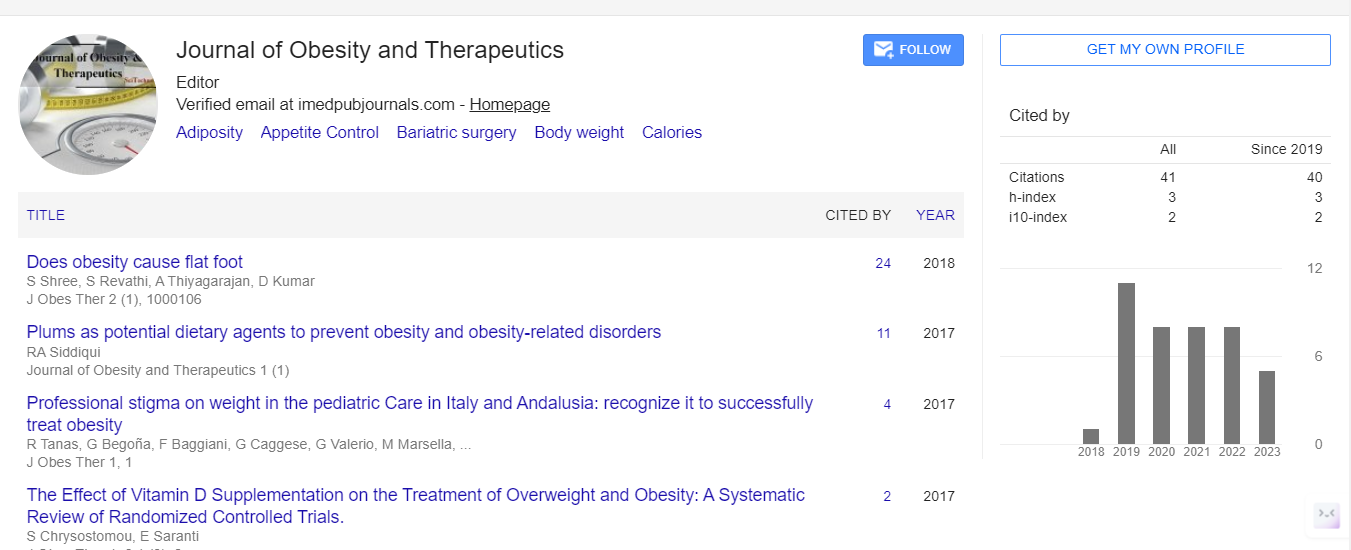Commentary, J Obes Ther Vol: 8 Issue: 3
Potential of Telehealth Programs in Delivering Effective Weight Loss Solutions to At-Risk Populations
Thiago Silva*
1Department of Nutrition and Dietetics, Washington State University, Pullman, Washington, USA
*Corresponding Author: Thiago Silva,
Department of Nutrition and Dietetics,
Washington State University, Pullman, Washington, USA
E-mail: thiago_silva@outlook.com
Received date: 23 August, 2024, Manuscript No. JOT-24-151550;
Editor assigned date: 26 August, 2024, PreQC No. JOT-24-151550 (PQ);
Reviewed date: 11 September, 2024, QC No. JOT-24-151550;
Revised date: 20 September, 2024, Manuscript No JOT-24-151550 (R);
Published date: 27 September, 2024, DOI: 10.4172/JOT.1000289
Citation: Ogunka-Nnoka CU, Ben-Piakor TE, Mepba HD, Ifeanacho MO (2020) Effect of Processing on Phytochemicals and Nutrient Composition of Tiger Nut (Cyperus esculentus L). J Food Nutr Disor 9:2. doi: 10.37532/jfnd.2020.9(2).271
Description
The prevalence of obesity is a significant public health concern globally, particularly among at-risk populations such as low-income individuals, ethnic minorities and those living in rural areas. These groups often face barriers to accessing traditional healthcare services, including nutrition counseling and weight management programs. As a response to these challenges, telehealth programs have emerged as a potential solution for delivering effective weight loss interventions. By utilizing technology, telehealth can provide accessible, flexible, and personalized weight loss solutions that meet the unique needs of atrisk populations. One of the primary advantages of telehealth programs is their ability to overcome geographic and logistical barriers to healthcare access. For many at-risk individuals, limited availability of local healthcare services, lack of transportation and inflexible work schedules can hinder participation in face-to-face weight management programs. Telehealth eliminates these barriers by allowing individuals to engage in consultations and counseling sessions from the comfort of their homes, using phones, tablets, or computers. This flexibility can lead to increased participation and sustained engagement in weight loss initiatives.
Moreover, telehealth platforms can reach a broader audience, including those in rural communities who may otherwise have limited access to weight management resources. In this way, telehealth can democratize access to vital health information and support, ensuring that underserved populations can benefit from effective weight loss interventions. Telehealth programs can offer personalized weight loss solutions tailored to the specific needs and circumstances of at-risk individuals. Through initial assessments and ongoing consultations, healthcare providers can create customized plans that consider various factors such as dietary preferences, physical capabilities and existing health conditions. This individualized approach can enhance engagement and adherence, as participants are more likely to follow a plan that resonates with their lifestyle and goals.
Additionally, telehealth can facilitate ongoing support through virtual check-ins, group sessions, or access to online communities. This continuous connection promotes accountability and motivation, which are critical components of successful weight loss. Programs that incorporate regular interactions with healthcare providers, such as dietitians, nutritionists, and exercise specialists, promote a sense of support that can be lacking in traditional programs. Many telehealth weight loss programs leverage evidence-based interventions, which can enhance their effectiveness. By incorporating cognitive-behavioral strategies, motivational interviewing and structured dietary plans, these programs can address the psychological and behavioral aspects of weight management. Research has shown that telehealth interventions yield positive weight loss outcomes comparable to in-person programs. For example, a systematic review found that remote interventions led to significant reductions in body weight and improvements in dietary habits among participants.
Moreover, technology enables the use of real-time data collection and monitoring of progress, such as through wearable devices or mobile apps. This data-driven approach allows healthcare providers to adjust plans as needed, ensuring that participants receive timely feedback and support. While telehealth programs offer considerable potential, challenges remain. Digital literacy disparities and access to reliable internet connections can hinder participation, particularly among older adults or low-income individuals. Therefore, it is important to ensure that these programs are designed with inclusivity in mind, offering training and resources to help all potential participants engage effectively. Furthermore, privacy and confidentiality concerns related to telehealth must be addressed to build trust among at-risk populations. Ensuring secure platforms and transparent policies is essential in promoting a safe environment for participants. The potential of telehealth programs in delivering effective weight loss solutions to at-risk populations is substantial.
 Spanish
Spanish  Chinese
Chinese  Russian
Russian  German
German  French
French  Japanese
Japanese  Portuguese
Portuguese  Hindi
Hindi 